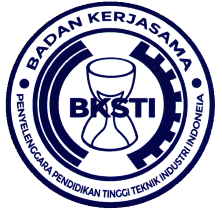Usulan Perbaikan Penempatan Barang pada Area Pemeriksaan Inbound Gudang Logistik dengan Metode Class Based Storage
DOI:
https://doi.org/10.52759/inventory.v2i1.30Keywords:
Class Based Storage Method, Layout, WarehouseAbstract
The company runs a business by providing services related to storage and handling of goods in warehouses to its customers, namely PT Semarang Autocom Manufacturing Indonesia Jepara (SAMI-JF) and Tugu (SAMI-TF). Goods from SAMI-JF and SAMI-TF customers have similarities so that checkers often have difficulty identifying and finding items to be inspected. This causes delays in checking goods in the inbound inspection area, resulting in a delay in the putaway process. This study aims to provide suggestions for improving the placement of goods in the inbound inspection area in the logistics warehouse. The method used is the Class Based Storage method. Based on data processing, the results of the proposed improvements are the location of goods placement in the logistics warehouse divided into two groups, namely groups A and B. Goods from SAMI-JF customers use the area from block 1 to block 19, while goods from SAMI-TF customers use blocks 20 to 38 blocks with a total distance of 2593.5 m. The results of the proposal are expected to reduce the occurrence of delays in checking goods in the inbound inspection area and completing putaways
Downloads
References
J. Johan and K. Suhada, “Usulan Perancangan Tata Letak Gudang dengan Menggunakan Metode Class-Based Storage (Studi Kasus di PT Heksatex Indah, Cimahi Selatan),” J. Integr. Syst., vol. 1, no. 1, pp. 52–71, 2018.
H. Juliana and N. U. Handayani, “Peningkatan Kapasitas Gudang dengan Perancangan Layout Menggunakan Metode Class-Based Storage,” J@ti Undip J. Tek. Ind., vol. 11, no. 2, p. 113, 2016.
M. G. Yunanto, Holy Icun; Santika, Business Concepts Implementation Series in Inventory Management. Jakarta: Elex Media Komputindo, 2005.
C. Makatengkeng, A. H. Jan, J. S. B. Sumarauw, and J. S. B. Sumarauw, “Analisis Sistem Manajemen Pergudangan pada PT Timur Laut Jaya Manado,” J. EMBA J. Ris. Ekon. Manajemen, Bisnis dan Akunt., vol. 7, no. 4, pp. 5924–5933, 2019.
A. N. Hakim, Perancangan Ulang Layout Ruang Penyimpanan Sampel Stabilitas Impermeable Berdasarkan Konsep Similarity dan Popularity serta Prinsip 5S (Studi Kasus di PT FPP). 2018.
S. Pandiangan, Operasional Managemen Pergudangan. Jakarta: Mitra Wacana Media, 2017.
T. H. Subagyo, Pangestu; Asri, Marwan; Handoko, Dasar-Dasar Operations Research, Edisi ke-2. Yogyakarta: BPFE, 1993.
S. N. Karonsih, N. W. Setyanto, and C. F. M. Tantrika, “Perbaikan Tata Letak Penempatan Barang di Gudang Penyimpanan Material Berdasarkan Class Based Storage Policy (Studi Kasus : Gudang Material PT Filtrona Indonesia - Surabaya),” J. Rekayasa dan Manaj. Sist. Ind., vol. 1, no. 2, pp. 345–357, 2013.
W. Setyawan and F. R. Fauzi, “Efektivitas Tata Letak Gudang Baru untuk Menekan Tingkat Kerusakan Produk Menggunakan Metode Class Based Storage,” J. Media Tek. dan Sist. Ind., vol. 4, no. 2, p. 100, 2020.
J. M. Apple, Tata Letak Pabrik dan Pemindahan Bahan, Edisi ke-3. Bandung: ITB, 1990.
N. P. A. Hidayat, “Perancangan Tata Letak Gudang dengan Metoda Class-Based Storage Studi Kasus CV SG Bandung,” J. Al-AZHAR Indones. SERI SAINS DAN Teknol., vol. 1, no. 3, p. 105, 2012.
Basuki and M. Hudori, “Implementasi Penempatan dan Penyusunan Barang di Gudang Finished Goods Menggunakan Metode Class Based Storage,” Ind. Eng. J., vol. 5, no. 2, pp. 11–16, 2016.
B. . Russel, R.S; Taylor, Operations Management, Edisi ke-7. USA: John Wiley & Sons, Inc, 2011.
M. H. Kusnawan, D. D. Damayanti, and B. Santosa, “Usulan Perancangan Alokasi Penyimpanan Produk Menggunakan Kebijakan Class Based Storage Untuk Mengurangi Waktu Delay Pada Gudang Bm PT XYZ Bandung Storage Allocation Design for Products Using Class Based Storage Policy To Reduce Delay Time in Bm Pt . Xy,” vol. 2, no. 2, pp. 4108–4115, 2015.
J. A. Tompkins, James A.; White, Facilities Planning, Fourth Edi. USA: Wiley, 2010.
H. Marimin; Tanjung, Hendri; Prabowo, Sistem Informasi Manajemen Sumber Daya Manusia. Jakarta: Grasindo, 2006.
J. D. Santosa, Lebih Memahami SOP (Standar Operating Procedure). Surabaya Kata Pena, 2014.
W. Setiawati, “Penyusunan Standard Operating Procedure (Sop) Pada Pt. Sketsa Cipta Graha Di Surabaya,” Agora, vol. 3, no. 1, pp. 514–522, 2015.




